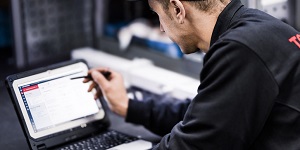Recently, we spoke to Jonny Phillips, Toyota Material Handling UK’s Technical Product and Training Engineer, to chat about the role of a Toyota STEP trainer.
What is STEP Training?
STEP (Service Technician Education Programme) training involves instructing new technicians to service trucks under safe conditions, with respect for the environment and to the highest quality standards. STEP training also encourages technicians to develop their ‘soft skills,’ which means learning about corporate culture, behaviour and business understanding while also expanding their commercial acumen.
Who undertakes STEP training?
STEP training is undertaken by all new service or workshop technicians. More specialised training on a particular product is also offered to experienced technicians who require a deeper, specialist knowledge.
Toyota has always believed that the true value of any company is its people. We recognise that training and development not only drive our employees’ career progression and personal growth, but we also understand that by developing our team members’ capabilities and skill sets we also benefit our customers.
What skills/ knowledge does STEP training aim to achieve?
Both the technical and ‘soft skills’ training sections of Toyota’s STEP deliver entry-level technical training for new recruits which focuses on basic fundamentals, such as truck inspections, periodical maintenance and understanding publications. In addition, more advanced training geared towards experienced technicians who want to specialise in a particular product technology is also offered.
-jpg.jpeg)
How does the Toyota Service Concept (TSC) interlink with the STEP training?
The Service Technician Education Programme is a crucial part of the Toyota Service Concept (TSC). TSC aims to adapt the lean principles of the Toyota Production System – which is designed for manufacturing operations – to our service business to deliver maximum reliability for our customers.
What software packages are used by the trainees in the field and what are the key features/ benefits of the software?
Each service technician is supplied with an impact resistant laptop that runs T-Stream, Toyota’s service software tool. Developed in partnership with Microsoft, T-Stream is built on Microsoft’s Azure cloud. It runs on Windows and utilises Bing Maps and GPS systems to provide technicians with the details they need to deliver a proactive planned maintenance schedule that keeps truck breakdowns and any resultant and potentially costly truck downtime to an absolute minimum.
Designed to integrate with other applications and technical documentation, features of T-Stream include an improved planner, parts finder and fleet management functionality.
T-Stream provides technicians with all the information they are likely to need when out ‘in the field’ - from an overview of service tasks to in-depth technical instructions. And, importantly, they can access it even when working at the most remote sites.
Being armed with real-time insights allows technicians to ensure that equipment operates predictably and efficiently, which, of course, results in lower repair costs.
Not only does T-Stream allow technicians to plan their work more efficiently, but also enables back-office staff to offer the highest levels of support rapidly, which benefits both the technician and the customer.

What is the structure of your average day and key tasks?
A standard day in the life of a STEP trainer involves the following.
- Check the course attendees, training area availability, required trucks, power outlets, and finally book lunches.
- Print any training documents required or transfer the information onto memory sticks.
- Set up the workshop or on-line presentation ready for either face to face training or on-line sessions.
- Explain the training tasks to be completed and help the technician understand as required.
- Monitor the technician throughout the day to ensure their progress is on track.
- Check the technician’s tasks have been completed & test the equipment to ensure its working correctly.
- Setup an LMS technician test after each module and provide any assistance if required.
- Tidy the workshop after the training has been completed.
Traditionally all courses were face-to-face and took place in a classroom or workshop setting but the pandemic changed that and now ‘students’ have the option to undertake some aspects of their STEP training online.
Remote, internet-hosted training works particularly well for technicians learning about the key features and benefits of the software that they’ll be using ‘in the field’. But being physically alongside technicians in a workshop environment allows me to monitor what they are doing closely and offer guidance if necessary – although I prefer them to resolve any problems for themselves, if possible.
What attracted you to the role?
The logistics and materials handling industry is an ever-changing environment and forklift truck technology is evolving rapidly. I like the fact that, by passing on my experience I am helping to bring through a new generation of technicians that work safely and efficiently and assist some of the more experienced colleagues with the skills they will need as they develop their careers with Toyota. I know that I am doing something that not only benefits our technicians on a personal level, but I’m also contributing to the success of the company and, just as importantly, our customers.
One of the most satisfying aspects of my role is seeing the sense of pride and achievement that new technicians get as they complete a task successfully.
What are your interests outside work?
Family life keeps me busy. I am a rugby fan and enjoy walking and cycling. I also try to find the time to relax occasionally – although opportunities to ‘put my feet up’ are something of a rarity!


